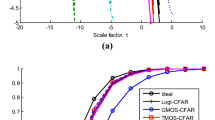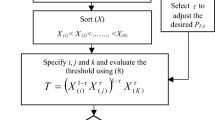Abstract
Constant false alarm rate (CFAR) detectors are developed to track changes in clutter intensities and to adapt the detection threshold to maintain a constant probability of false alarms. These adaptive thresholding mechanisms are initially intended when both target and clutter are exponentially distributed, and they degrade in performance when applied to newer target and clutter models. So, in application scenarios like Airborne Warning and Control Systems (AWACS) and ship remote sensing, when both the target and clutter are Pareto distributed, instead of the conventional way of tweaking the existing adaptive-thresholding CFAR detector, we pose the detection problem as a two-sample, Pareto vs. Pareto composite hypothesis testing problem. Considering no knowledge of both scale and shape parameters of Pareto distributed clutter, we derive the new adaptive-thresholding detector based on the generalized likelihood ratio test (GLRT) statistic. We further show that our proposed adaptive thresholding detector has a CFAR property and provide extensive simulation results to demonstrate the performance of the proposed detector.









Similar content being viewed by others
Availability of Data and Material
N/A.
Code Availability
N/A.
References
Barton, D. K. (2004). Radar system analysis and modeling. Artech House.
Rohling, H. (1983). Radar CFAR thresholding in clutter and multiple target situations. IEEE Transactions on Aerospace and Electronic Systems, 4, 608–621.
Richards, M. A., Scheer, J., Holm, W. A., & Melvin, W. L. (2010). Principles of modern radar. Citeseer.
Gandhi, P. P., & Kassam, S. A. (1994). Optimality of the cell averaging CFAR detector. IEEE Transactions on Information Theory, 40(4), 1226–1228. https://doi.org/10.1109/18.335950
Johnston, S. L. (1997). Target fluctuation models for radar system design and performance analysis: an overview of three papers. IEEE Transactions on Aerospace and Electronic Systems, 33(2), 696–697. https://doi.org/10.1109/7.588491
Johnston, S. L. (1997). Target model pitfalls (Illness, diagnosis, and prescription). IEEE Transactions on Aerospace and Electronic Systems, 33(2), 715–720. https://doi.org/10.1109/7.588498
Wilson, J. D. (1972). Probability of detecting aircraft targets. IEEE Transactions on Aerospace and Electronic Systems, AES–8(6), 757–761. https://doi.org/10.1109/TAES.1972.309606
Richards, M. A. (2005). Fundamentals of radar signal processing. McGraw-Hill Education.
Persson, B. (2017). Radar target modeling using in-flight radar cross-section measurements. Journal of Aircraft, 54(1), 284–291. https://doi.org/10.2514/1.C033932. Accessed May 2, 2018.
Gali, J. B., Ray, P., & Das, G. (2020). Uniformly most powerful CFAR test for Pareto-target detection in Pareto distributed clutter. 2020 National Conference on Communications (NCC) (pp. 1–6). IEEE. https://doi.org/10.1109/NCC48643.2020.9056098
Weinberg, G. V. (2017). Noncoherent radar detection in correlated pareto distributed clutter. IEEE Transactions on Aerospace and Electronic Systems, 53(5), 2628–2636. https://doi.org/10.1109/TAES.2017.2705498
Rosenberg, L., Watts, S., & Greco, M. S. (2019). Modeling the statistics of microwave radar sea clutter. IEEE Aerospace and Electronic Systems Magazine, 34(10), 44–75. https://doi.org/10.1109/MAES.2019.2901562
Farshchian, M., & Posner, F. L. (2010). The Pareto distribution for low grazing angle and high resolution X-band sea clutter. IEEE (pp. 789–793). https://doi.org/10.1109/RADAR.2010.5494513. http://ieeexplore.ieee.org/document/5494513/. Accessed May 2, 2018.
Weinberg, G. V. (2011). Assessing Pareto fit to high-resolution high-grazing-angle sea clutter. Electronics Letters, 47(8), 516–517. https://doi.org/10.1049/el.2011.0518
Xue, J., Xu, S., & Shui, P. (2019). Coincidence of the RAO test, Wald test and GLRT for radar target detection in generalized pareto clutter. In 2019 IEEE International Conference on Signal Processing, Communications and Computing (ICSPCC) (pp. 1–4). IEEE. https://doi.org/10.1109/ICSPCC46631.2019.8960751
Weinberg, G. V., & Tran, C. (2019). A Weber-Haykin detector in correlated pareto distributed clutter. Digital Signal Processing, 84, 107–113. https://doi.org/10.1016/j.dsp.2018.10.007
Weinberg, G. V. (2011). Coherent multilook detection for targets in pareto distributed clutter. Electronics Letters, 47(14), 822–824. https://doi.org/10.1049/el.2011.0963
Weinberg, G. V. (2013). Constant false alarm rate detectors for pareto clutter models. IET Radar, Sonar Navigation, 7(2), 153–163. https://doi.org/10.1049/iet-rsn.2011.0374
Weinberg, G. V. (2013). Assessing detector performance, with application to pareto coherent multilook radar detection. IET Radar, Sonar Navigation, 7(4), 401–412. https://doi.org/10.1049/iet-rsn.2012.0127
Weinberg, G. V. (2014). Examination of classical detection schemes for targets in Pareto distributed clutter: do classical CFAR detectors exist, as in the Gaussian case? Multidimensional Systems and Signal Processing, 26(3), 599–617. https://doi.org/10.1007/s11045-013-0275-y. Accessed November 15, 2015.
Weinberg, G. V. (2014). General transformation approach for constant false alarm rate detector development. Digital Signal Processing, 30, 15–26. https://doi.org/10.1016/j.dsp.2014.04.010. Accessed March 25, 2015.
Weinberg, G. V. (2014). Constant false alarm rate detection in Pareto distributed clutter further results and optimality issues. Contemporary Engineering Sciences, 7, 231–261. https://doi.org/10.12988/ces.2014.3737. Accessed June 2, 2019.
Weinberg, G. V. (2017). On the construction of CFAR decision rules via transformations. IEEE Transactions on Geoscience and Remote Sensing, 55(2), 1140–1146. https://doi.org/10.1109/TGRS.2016.2620138
Weinberg, G. V. (2017). An invariant sliding window detection process. IEEE Signal Processing Letters, 24(7), 1093–1097. https://doi.org/10.1109/LSP.2017.2710344
Casella, G., & Berger, R. L. (2021). Statistical inference. Cengage Learning.
Balakrishnan, N., & Nevzorov, V. B. (2004). A primer on statistical distributions. John Wiley & Sons.
Kay, S. M. (1998). Fundamentals of statistical signal processing: Detection theory Prentice-Hall PTR. Upper Saddle River, New Jersey.
Malik, H. J. (1970). Estimation of the parameters of the pareto distribution. Metrika, 15, 126–132.
Funding
None.
Author information
Authors and Affiliations
Contributions
N/A.
Corresponding author
Ethics declarations
Ethics Approval
N/A.
Consent to Participate
N/A.
Consent for Publication
N/A.
Conflict of Interest
N/A.
Additional information
Publisher's Note
Springer Nature remains neutral with regard to jurisdictional claims in published maps and institutional affiliations.
Appendix: Mathematical Simplifications
Appendix: Mathematical Simplifications
Simplification of Eq. (21) follows from (43). Further, from Eq. (24), arriving at threshold\(- p_{fa}\) relation (25) is as follows:
where the equalities are justified as follows: (a) for \(B \text { and } C\) are independent random variables and their joint density products down; (b) by taking expectation with respect to the C random variable; (c) by the complementary cdf formula; (d) by applying moment generating function formula for C, followed by simplification.
For Eq. (27) following the similar lines of above justification, but under \(H_1\), the simplification steps are:
Similarly for (case (b)), from Eq. (40) arriving at (41) is as follows:
where the equalities are justified as follows: (a) for \(G \text { and } D\) are independent random variables; (b) substituting the density function for \(g>0\) in (39) as \(\gamma d >0\); (c) by taking expectation with respect to the D random variable; (d) by applying moment generating function formula for D, followed by simplification.
Rights and permissions
Springer Nature or its licensor (e.g. a society or other partner) holds exclusive rights to this article under a publishing agreement with the author(s) or other rightsholder(s); author self-archiving of the accepted manuscript version of this article is solely governed by the terms of such publishing agreement and applicable law.
About this article
Cite this article
Gali, J.B., Ray, P. & Das, G. GLRT Based Adaptive-Thresholding for CFAR-Detection of Pareto-Target in Pareto-Distributed Clutter. J Sign Process Syst 96, 313–326 (2024). https://doi.org/10.1007/s11265-024-01909-8
Received:
Revised:
Accepted:
Published:
Issue Date:
DOI: https://doi.org/10.1007/s11265-024-01909-8




